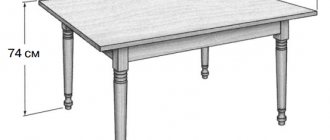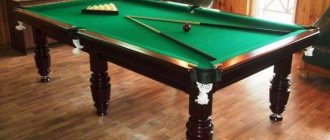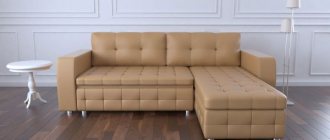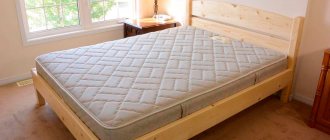Despite the abundance of various furniture in stores, a simple stool has been and remains a fairly popular piece of furniture in the home. It is especially relevant if the apartment is decorated in a rustic style - in a kitchen with such a design, an ordinary stool will be simply irreplaceable.
But it’s not easy to buy a quality product now, so it’s easier to make it yourself. How to make a stool with your own hands from wood? The drawing, diagram and step-by-step instructions are in this material.
How to make a stool with your own hands from wood
Types of stools
Stools or chairs without legs come in different types. A limited number of models are sold in furniture stores. In turn, there are many more types of hand-made stools:
- Classic kitchen stool
- Transformable chair
- Miniature stool
- Bar stool
- Stool with drawers
- Stool with height adjustment
- garden furniture
- Folding model
- Step stool
The most important thing is that you can make a stool of any size and any design, which is clearly illustrated by various photos of hand-made stools from different craftsmen.
The evolution of a backless chair
According to frescoes and writings, stools appeared in ancient times. Initially, the product was a small bench. The seat board was installed on 2 supports (stones, logs). The thing was for a long time the preserve of the nobility.
In the Middle Ages, stools acquired shapes close to modern ones. Later, variations with a storage box, products with a single support leg, and rotating models appeared.
Materials for the stool
One of the advantages of making your own stool is that it can be made from any material. Many owners choose environmentally friendly materials:
- Tree
- MDF
- laminated chipboard
That is why the question often arises of how to make a stool out of wood with your own hands. Solid wood is a very expensive material and such furniture is rare on the open market. However, it’s not difficult to do it yourself; you just need to stock up on a few boards. In this case, the boards can be from:
- Pines are the most inexpensive tree.
- Oak or beech - durable tree varieties
- Aspen, ash or linden - their wood is silky and tender. But such wood is short-lived.
In addition to natural wood, you can also use ordinary wood for the stool from old furniture made of chipboard or MDF. For this furniture, you can even use regular plywood or thick cardboard.
Product Features
The classic stool contains a seating area on 4 support legs, which are located at the edges. The product may have 3 legs, which are attached to the center of the back side of the seat. The legs can be connected by drawers and legs. Bar and musical stools often have a single support leg.
Stool design features
To make a stool, different materials can be used, but most often craftsmen take ready-made timber, waste wood or ordinary plywood. These are cheaper and more reliable materials that are used in the furniture industry. Working with wood is not difficult, so if you have a ready-made drawing, you can easily make a kitchen stool.
Most often, stools are made of wood
In the classical sense, a stool is several elements securely connected to each other. These include:
- the base of the stool, which has a square shape (sometimes the base of the structure is round);
- durable legs in the amount of 3 or 4 pieces;
- fasteners that connect the legs of the product. They are called kings;
- a seat with rounded edges.
Creative wooden stools
For convenience, the surface of the seat is covered with thick fabric or leather. Such stools will look more presentable.
Stool Tools
In addition to the materials to create such furniture, you will also need the following tools:
- Pencil, ruler and tape measure
- Jigsaw
- Hammer
- Nails
- Hacksaw
- Sandpaper
- Screwdriver or drill
- Wood glue
Advice. Small tools and parts, such as nails or screws, should be laid out separately on a white cloth - this will make them easier to find and take while making the stool.
Drawings for a stool
Before you start making the product, it is important to think through and calculate the drawings of the stool. It is important to take into account the standard sizes:
- The seat width can be 40-45 cm.
- Seat height – 65-75 cm.
- Height for a bar stool – 90-120 cm.
Height from the floor and seat width are the main dimensions. In addition to them, additional ones need to be taken into account:
- Width and size of legs
- The height of placement of the drawers or crossbars that stand between the legs
- Bottom bars between legs, if planned
- Additional oblique fastenings for drawers
After the drawings are made, it is necessary to transfer them to the material. And then cut wood, chipboard or plywood according to specific patterns.
Advice. For the seat, you can use chipboard or plywood, and for the legs and drawers it is better to use solid wood. You can make a stool entirely from chipboard with your own hands, but this will make the furniture less wear-resistant.
Creative stage
At the very first stage, every creator must imagine in his imagination what he wants to create. The shape of a home stool should be quite stable and therefore you should not get carried away with the elongated shapes of their fellows standing near the bar counters.
Note!
The stool should be low - no higher than 500-600 mm from the floor level and slightly different from the cubic shape.
Then it will be both a wonderful resting place and a stand on which you can pick apples or paint the ceiling. The seat area should be from 350x350 mm to 500x500 mm. Therefore, creativity should end with the design of a drawing of a stool with dimensions that allow one to accurately calculate the need for materials (Figure 1).
Stool legs
How to assemble a stool
Once the main parts have been cut or created, you can begin to assemble the furniture. The assembly process occurs in the following sequence:
- Each part must be sanded and polished with sandpaper
- Use a pencil to mark places on the legs for attaching drawers or additional parts.
- Once again, try on the height of the legs and drawers, then mark and drill holes for the screws
- Apply glue to the joints of the parts: drawer and legs
- Connect the drawers to the legs
- Install additional fasteners between the drawers.
- Place the seat upside down. Install the legs with drawers on it and secure it.
- Install additional crossbars or other parts between the legs.
- Cover the product with varnish and apply decor.
Original furniture ideas
The size of the stool depends entirely on the ideas that the owners want to bring to life. In addition to the standard four-legged stool, it can be:
- A small folding chair with three or four legs, which is created from a flexible seat and three base legs.
- Step stool, where an additional step extends
- A transformable chair that can be furniture with a backrest or a stepladder
The most complex design is a transforming chair, the seat of which is made of two halves. One of them can serve as an additional step when turning into a stepladder.
For a step stool, you need to make an additional step, which will be smaller than the seat, and will also have two additional legs. Also, for such a design you will need crossbars with puzzles, with the help of which an additional step will be extended.
Where to begin
It is immediately necessary to clarify that there are several options for homemade stools. The product can be folded or combine the function of a stepladder; there are high chairs and practical benches, complemented by drawers. If we talk about a classic stool, it consists of the following elements:
- a rectangular or square seat with a side of 300 mm; a round seat with a radius of about 350 mm is often made;
- legs - 4 pieces, made of rectangular timber 400-500 mm high;
- drawers - the upper trim of the legs in the amount of 4 pieces, giving the structure the necessary rigidity;
- The legs are additional stiffening ribs that are installed in the middle of the support posts.
A simple design involves straight wooden legs. They are the easiest to cut and secure. This is exactly what the configuration of an ordinary wooden stool looks like, capable of taking its rightful place in the kitchen. The sizes vary and depend on the height of who will most often use such furniture and for what purpose, but most often the height is about 40 cm.
Stool decor
After the stool is assembled, the entire product should be processed and stylishly decorated. To make the stool last longer you need to:
- Apply glue to all seams and joints of parts.
- Cover the legs and others with several layers of varnish
- Cover the legs or drawers with painting
- Decoupage the legs and then also varnish them
A stool where the lower part of the legs is painted or covered with decoupage pictures looks stylish.
Advice. Another option for decorating a stool is to decorate the legs in an antique style. This will require additional paint and wax. First you need to paint the edges of the legs with contrasting paint, and then treat it with wax and rub it in. After that, paint again with a different paint. This will create stylish creases and antique cracks.
Seat decoration
The final moment will be the design of the seat. Sitting on a hard chair is very uncomfortable. Therefore, for a stool it is better to choose the following options:
- Static foam seat. To do this, the foam rubber is glued to the seat, and a removable pillowcase is pulled on top.
- Removable pillow with leg ties
- Soft pillowcase with elastic band and foam insert
- Simple Fur Cape
To make the stool comfortable and comfortable, the seat should be soft and well secured: with an elastic band or ties.
Then the guests will be happy, and the household will love this piece of furniture because of its warmth and comfort.
Additional work
There are a few extra steps you can take to customize your custom stool and ensure it will last in your home. Most often, the stool is used in kitchens, verandas, garages and other rooms where the floor is made of concrete, covered with ceramic tiles or linoleum. In order to prevent the stool from slipping and thereby avoid possible injuries, it makes sense to glue a piece of sandpaper (null paper) to the supporting part of each leg. If you have to sit on a stool during long work, then it is quite advisable to upholster the seat with a piece of old leatherette, laying 10-15 mm thick foam rubber as a pad, or make a soft seat.











